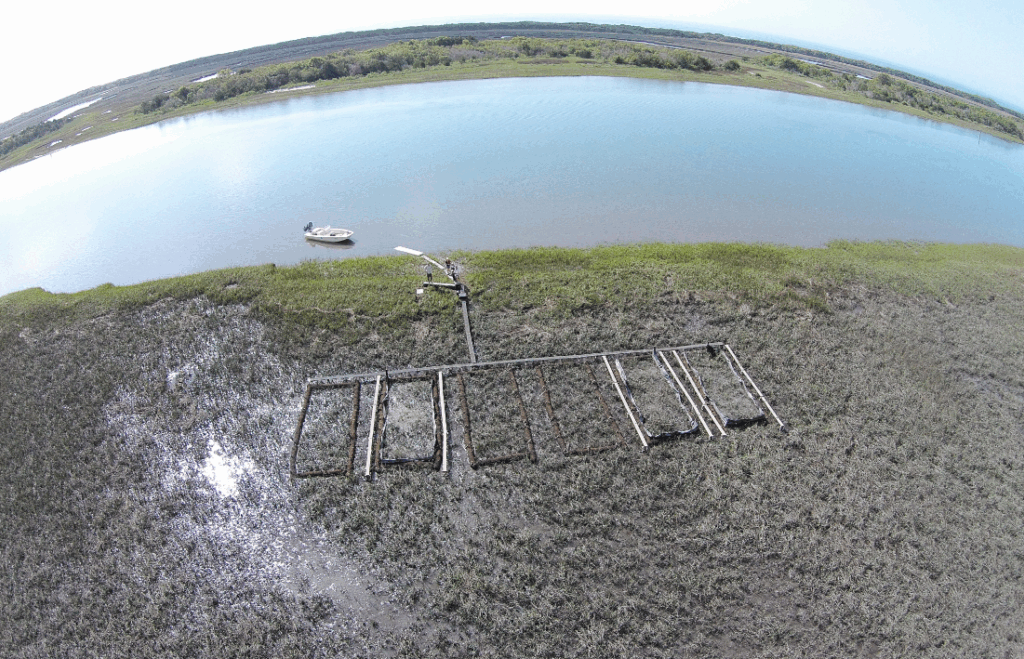Salt marshes are an incredibly important, though often overlooked part of marine and coastal ecosystems. They provide many ecosystem services, such as carbon sequestration, water filtration through the removal of excess nutrients, and flooding reduction. They also provide habitat for many threatened organisms, such as saltmarsh sparrows. Salt marshes are supposed to accrete at a rate equal to sea level rise, but as sea level rise increases more rapidly, and the water coming in with the tides becomes more sediment limited, many salt marshes are eroding. One proposed solution to reduce salt marsh drowning are thin-layer sediment placement projects. Thin layer placement (TLP), is the practice of spraying fine sediments, like silt and clay, onto the top of salt marshes to mimic vertical accretion(Davis, 2022). The idea behind TLP is that by depositing large volumes of sediment on top of an eroding, but otherwise healthy marsh, the marsh will be at a lower risk for drowning, marsh plants will be healthier due to the influx of nutrients, and the risk of panne formation, which leads to fragmentation, will be lower.
The process is expensive, and highly debated as a reliable restoration method. Sediment is locally dredged and filtered before being deposited onto the target marsh. The spraying itself is also fairly expensive, and securing the funding is a long and tedious process. Besides the expense, one of the primary concerns is the short-term health of the marsh. In the long term, vegetation has been shown to increase in abundance and range(Raposa, 2020). However, covering a marsh with sediment harms organisms in the short-term. Fiddler crab burrows are partially covered over, birds that nest in marshes may lose their nests, and plants struggle to receive proper sunlight, or can be knocked over with the weight of the sediment. It is often necessary for new seedlings to be planted in the marsh after TLP to bolster struggling plant populations. The policy for TLP is also very loose in many states, and the legislation is the same for salt marsh development as it is for TLP.

Experimental plots used for TLP testing in a marsh that recently underwent sediment place. Photo credit: NOAA
One of the main cited benefits of TLP is increased accretion rates in salt marshes. However, some marshes undergo a process called self-cannibalism. This is when certain parts of the marsh begin to erode, and instead of the sediment from those portions exiting the marsh, they instead flow back into other areas, making it seem like accretion rates are higher when the marsh is actually shrinking horizontally. It is possible that accretion rates are being falsely inflated with sediment placement projects, as there is an increase in self cannibalism due to the destabilization of certain sections where plants died off due to the initial sediment placement.
Thin layer placement projects are a promising method to decrease salt marsh erosion, but without further research, it is simply not reliable enough to jeopardize the health of some of our most important shorelines.
Citations
Davis, J., Currin, C., and Mushegian, N. 2022. Effective use of thin layer sediment application in Spartina alterniflora marshes is guided by elevation-biomass relationship. Ecological Engineering, 177; 106566. https://doi.org/10.1016/j.ecoleng.2022.106566
Developing a framework for assessing the benefits and the feasibility of thin layer placement in South Carolina. S.C. Sea Grant Consortium. (2025, July 23). https://www.scseagrant.org/thin-layer-placement-assessment-framework/
Myszewski, M., & Alber, M. (2017). Use of thin layer placement of dredged material for salt … Georgia Coastal Research Council. https://www.gcrc.uga.edu/wp-content/uploads/2019/10/Thin-Layer-Placement-Report-final3.pdf
NOAA. (2022, March 30). Thin layer sediment placement boosts marsh growth. NCCOS – National Centers for Coastal Ocean Science. https://coastalscience.noaa.gov/news/thin-layer-sediment-placement-boosts-marsh-growth-in-new-experimental-study/Raposa, K. B., Bradley, M., Chaffee, C., Ernst, N., Ferguson, W., Kutcher, T. E., McKinney, R. A., Miller, K. M., Rasmussen, S., Tymkiw, E., & Wigand, C. (2022). Laying it on thick: Ecosystem effects of sediment placement on a microtidal Rhode Island Salt Marsh. Frontiers in Environmental Science, 10. https://doi.org/10.3389/fenvs.2022.939870